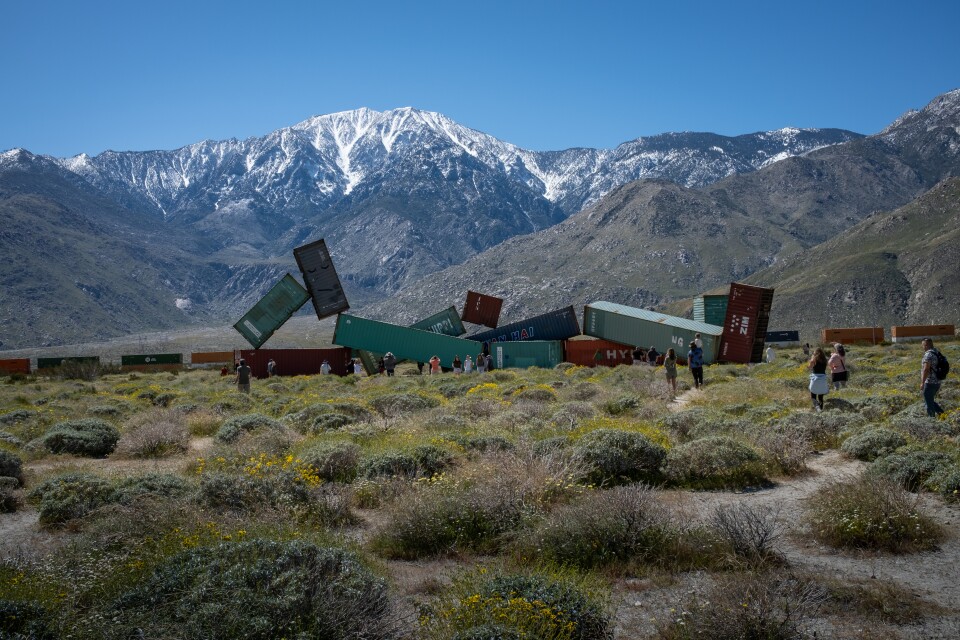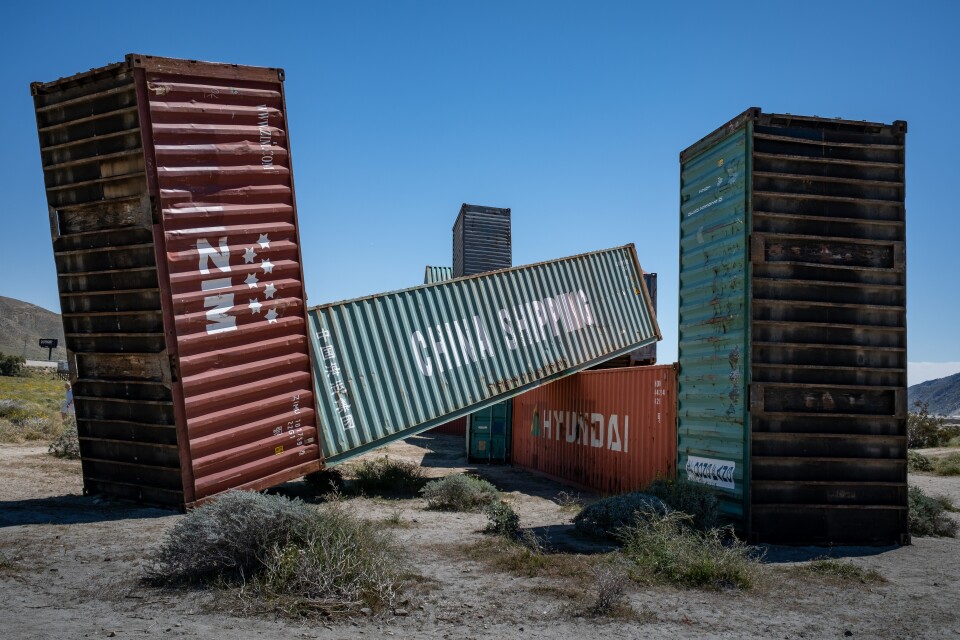Truth matters. Community matters. Your support makes both possible. LAist is one of the few places where news remains independent and free from political and corporate influence. Stand up for truth and for LAist. Make your tax-deductible donation now.
There's Something Else Blooming In The Desert: Massive Art Installations

Every two years, the floor of the Coachella Valley blooms with eye-catching, often colorful displays dotting the desert floor. You might be tempted to pull off on the Interstate 10 shoulder and take a look. But don’t: it’s not safe.
I’m not talking about wildflowers — even though there are now plenty of vivid displays of gold poppies and purple verbena around Palm Springs and nearby Anza-Borrego Desert State Park. Instead, it’s the biennial, site-specific art installations that are part of Desert X.
Launched in 2017, Desert X this year features new works from 12 artists, two of them from Los Angeles. It's produced by The Desert Biennial, a non-profit whose mission is to "create and present international contemporary art exhibitions that engage with desert environments through site-specific installations by acclaimed artists from around the world."
If you're traveling from Los Angeles, one of the first pieces you encounter is one of the most jarring. It’s called Sleeping Figure, created by L.A.-based Matt Johnson. It’s situated in a strip of arid land south of the freeway, north of busy freight train tracks, with the snow-capped summit of Mt. San Jacinto behind.

From a short distance, Sleeping Figure doesn’t look like art; it first appears to be yet another of the train derailments that have been in the news recently — a pile of shipping containers leaning every which way. But as you draw closer, you not only realize it’s not an accident but an art installation — boxcars, welded together, which form a giant, human-like body at rest. It is constructed from 12 shipping containers of various colors from companies around the world — just like the ones on the passing trains.
“I always wanted to position it along the freeway, the freight rail, and I wanted the mountain as a backdrop, because the figure becomes like an actor on a stage. And it becomes almost like a painting,” Johnson told me on a recent weekend.

Johnson said he was inspired two years ago when the freighter Ever Given blocked the Suez Canal for six days, causing a global backup in the delivery of goods.
“It was about that time that I started thinking about the shipping containers as a unit to make something with, like an object to build a sculpture from,” Johnson said. “The whole supply chain was interrupted, and it cast a real bright light on how we get things, where they come from, and the process with which goods move around the world.
I asked Johnson where you buy a used shipping container, assuming it's not on eBay.
"There's a secondhand yard at the Port of Long Beach where you can just pull up a truck and buy them, " Johnson said. He said he picked the containers based on their color and country of origin; there are containers from China, South Korea and Canada, among other nations.
"I wanted a global representation. But I also wanted a nice color palette of a variety of colors," Johnson said.

Sleeping Figure’s proximity to the tracks, however, can change the conversation around the work. “When we were starting to set it up, we were talking about what the train conductors must think when they're driving by,” Johnson said. “How they might think, is this some sort of sculpture or does this have something to do with the recent derailments in the country?”
That kind of questioning also factors into the installation by Lauren Bon, the other Los Angeles artist in Desert X this year. Bon’s work at Metabolic Studio near the L.A. River in downtown Los Angeles is often focused on the use — and reuse — of water. Her piece is called The Smallest Sea With the Largest Heart.

Bon has taken over an abandoned swimming club and its pool in Palm Springs proper.
The pool is filled with 20,000 gallons of toxic water from the nearby Salton Sea. And in its deep end is a hollow, metallic, scale model of a blue whale’s heart.
Through a solar-powered, electrical-chemical reaction, the water’s pollutants are bonding to the heart, giving it a new coating, as the water turns clearer and clearer over the weeks of its installation.

“When I was thinking about a piece for Desert X, I wanted to make a piece about speculative ecology that does a rewrite of the idea of ruin,” Bon told me. “When we talk about something as ruin, it often ceases to engage our imagination, it becomes something kind of dark or unapproachable. And I think in this precarious moment of climate change, it's important that we create speculative ecologies that make us rethink these things we call ruins.”
Several times in the evening, the sculpture is lifted out of the water by a pulley system. The heart grows more solid, the water less opaque. It’s both art and environmental repair in real time.
“When we make works with water, especially saltwater, we make works about our bodies,” Bon said. “And when we bring in the heart as a metaphor for a hydraulic pump, we also think about the condition with which the water is delivered to us — this vast hydraulic network of the Intermountain West.”
Desert X runs through May 7. The installations are free to visit, but some require timed admission reservations. For more information, go to desertx.org.








